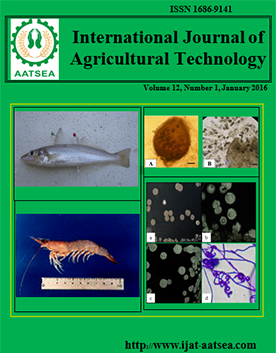Huanglongbing (HLB) incidence on 2-3 years old tangerine trees (Citrus reticulata) grown from disease-free nursery stock
Main Article Content
Abstract
Article Details

This work is licensed under a Creative Commons Attribution-NonCommercial-NoDerivatives 4.0 International License.
References
Akarapisan, A., piwkhao K., Chanbang, Y., Naphrom, D. and Santasup, C. (2008). Occurrence of huanglongbing disease of pomelo (citrus grandis) in northern thailand. Proceedings of the 1th international Research Conference on Huanglongbing. 1-5 December 2008. Orlando, Florida. USA. pp. 381-385.
Brlansky, R. H. and Rogers, M. E. (2007). Citrus Huanglongbing: understanding the vector-pathogen interaction for disease management. APSnet Features. doi: 10.1094/APSnetFeature-2007-1207.
Da Graca, J. V. (1991). Citrus greening disease. Annual Review Phytopathology 29:109-136.
Grafton-Cardwell, E. E., Stelinski, L. L. and Stansly, P. A. (2013). Biology and management of asian citrus psyllid, vector of the Huanglongbing pathogens. Annual Review of Entomology 58: 413-432.
Halbert, S. E., Manjunath, K., Ramadugu, C. and Lee, R. F. (2012). Incidence of Huanglongbing associated ‘Candidatus Liberibacter Asiaticus’ in Diaphorina citri (Hemiptera: Psyllidae) collected from plants for sale in Florida. Florida Entomologist 95:617-624.
Hocquellet, A., Toorawa, P., Bové, J. M. and Garnier, M. (1999). Detection and identification of the two Candidatus Liberobacter species associated with citrus huanglongbing by PCR amplification of ribosomal protein genes of the b operon. Molecular and Cellular Probes 13:373-379.
Hung, T. H., Hung, S. C., Chen, C. N., Hsu, M. H. and Su, H. J. (2004). Detection by PCR of Candidatus Liberibacter asiaticus, the bacterium causing citrus huanglongbing in vector psyllids: application to the study of vector–pathogen relationships. Plant Pathology 53:96-102.
Jagueix, S., Bové, J. M. and Garnier, M. (1997). Comparison of 16S/23S ribosomal intergenic regions of “Candidatus Liberibacter asiaticum” and “Candidatus Liberibacter africanum” the two species associated with citrus Huanglongbing (greening) disease. International Journal of Systematic Bacteriology 47:224-227.
Ruangwong, O. and Akarapisan, A. (2006). Detection of Candidatus Liberibacter asiaticus causing citrus Huanglongbing disease. Journal of Agricultural Technology 2:111-120.
Stover, E. and McCollum, G. (2011). Incidence and severity of Huanglongbing and Candidatus Liberibacter asiaticus titer among field-infected citrus cultivars. Hort Science 46:1344-1348.
Tsai, J. H. (2008). Asian citrus psyllid, Diaphorina citri Kuwayama (Hemiptera: Psyllidae). Encyclopedia of Entomology. pp. 306-308.
Xu, C. F., Xia, Y. H., Li, K. B. and Ke, C. (1988). Further study of the transmission of citrus huanglongbing by a psyllid, Diaphorina citri Kuwayama in Proceeding of the 10th Conference, Organic Citrus Virol. pp. 243-248.


